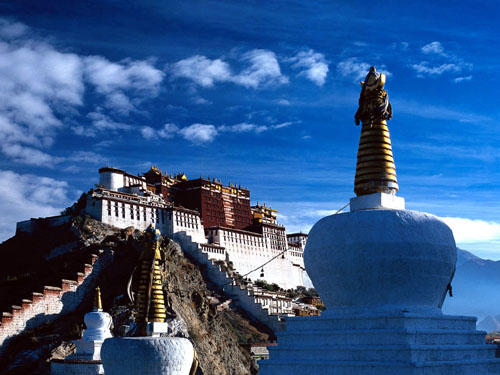
Since early time before Christ, ancient people began to reside on the Qinghai-Tibet Plateau in southwest China. After a prolonged period of time, tribes that had scattered on the plateau gradually united and formed a nationality known as the Tibetan ethnic group today.
Having suffered successive wars in the early period of the Tang Dynasty (618-907), the Tibetans fostered cordial relations with the Tang court by marriage links. Tibetan people began their trade ties with the Central Plains in the Song Dynasty (960-1279) on a barter basis. As time went on, in the Yuan Dynasty (1206-1368), the already multi-ethnic realm of China was reunified, with Tibet organically included as an administrative unit ruled by the central court of Yuan. Since then, Tibetans, along with other ethnic groups under the central authorities, had experienced the rise and fall of dynasties and witnessed resultant changes in the history of China.
Tubo Kingdom
Early in the seventh century, the powerful Tang Dynasty was founded in the Central Plains, ending the disintegration and chaotic situation that had prevailed in the region for more than 300 years. At the same time, Tubo leader Songtsan Gambo welded together more than 10 separate tribes and established the Tubo Kingdom covering a large part of what later became known as Tibet. He twice sent ministers to the Tang court requesting a member of the imperial family be given to him in marriage, and in 641, Princess Wencheng, a member of Emperor Taizong's family, was chosen for this role. During the reign of Songtsan Gambo, political, economic and cultural relations between the two nations became increasingly friendly and extensive. This pattern of friendly relations was carried on during the next 200 years or more.
In 821, then Tubo King Tri Ralpachen dispatched envoys to Chang'an, capital of the Tang Dynasty for three times, asking for alignment. Muzong, then Emperor of the Tang Dynasty, appointed his senior officials to hold a grand alignment ceremony in the western suburb of Chang'an. In the next year, the Tang Dynasty and the Tubo Kingdom formally concluded their alliance pact in the eastern suburb of Lhasa. The two sides of the alliance reiterated their close relations bound by marriage and decided to treat each other as a member of one family. The alignment was recorded on three Tang-Tubo Peace Pledgement Monuments, one of which still stands in front of the Jokhang Monastery in Lhasa.
In 842, the Tubo Kingdom broke up, and rival groups of ministers, members of the royal family and various tribes plunged into internecine struggle that was to last in varying levels of intensity for the next 400 years. Reeling under the detrimental impact of such activities on their economic and cultural development, people on the Tibetan Plateau looked to the emergence of a formidable regime on the Central Plains to someday come to their rescue. Those who could no longer stand the bitterness fled to areas in present-day Gansu, Qinghai, Sichuan and Yunnan provinces.
Yuan Dynasty (1206-1368)
In the early 13th century, the leader of the Mongolian people, Genghis Khan, established the Mongol Khanate in the north of China. In 1247, Mongol Prince Godan invited Pandit Gonggar Gyamcain, an eminent monk with the Sagya Sect that greatly influenced Buddhist worship on the Tibetan Plateau, to a meeting in Liangzhou (present-day Wuwei in Gansu Province). Pandit Gonggar Gyamcain offered the submission of Tibet to the Mongol Khanate and the acceptance of a defined local administrative system. In return, the Sagya Sect was given political power in Tibet. In 1271, the Mongolian conquerors took Yuan as the name of their dynasty. In 1279, they finally unified the whole of China. The newly united central authorities continued control over Tibet, including it as a directly governed administrative unit.